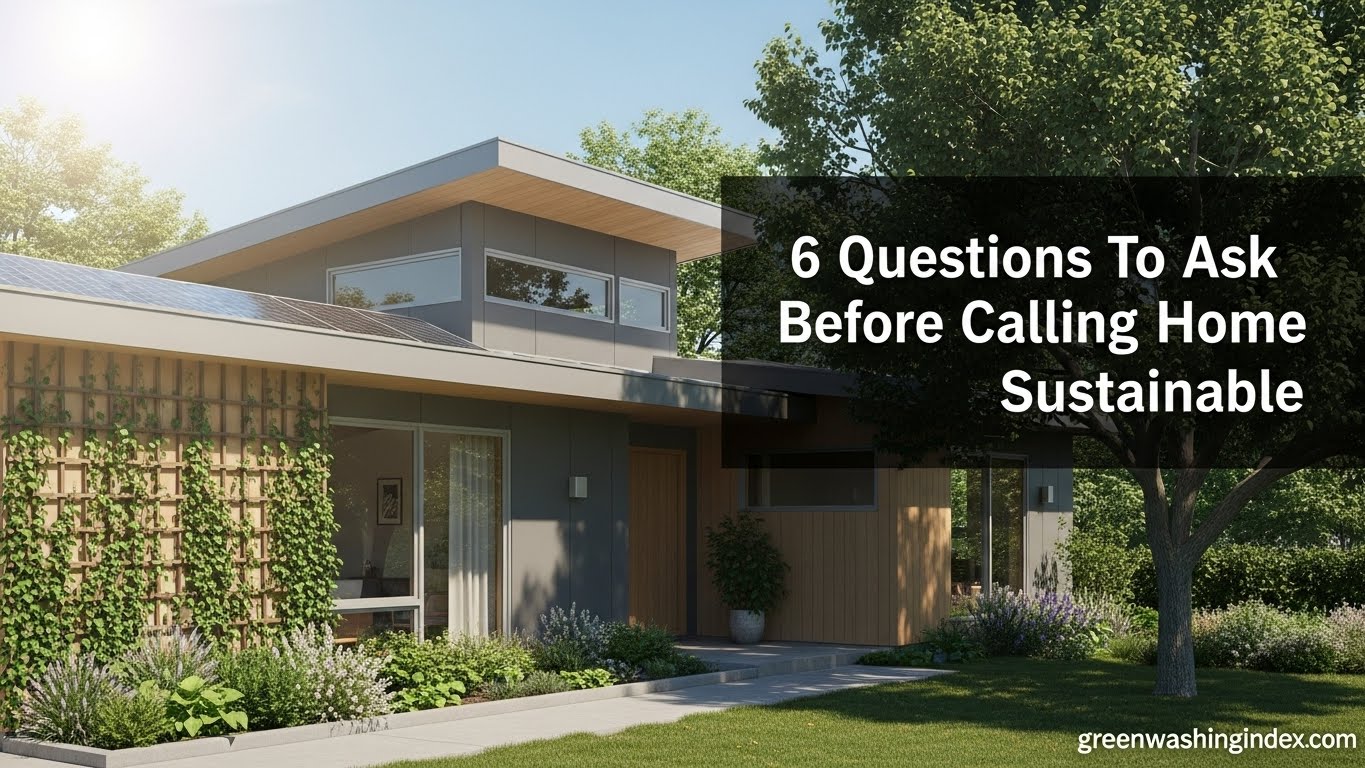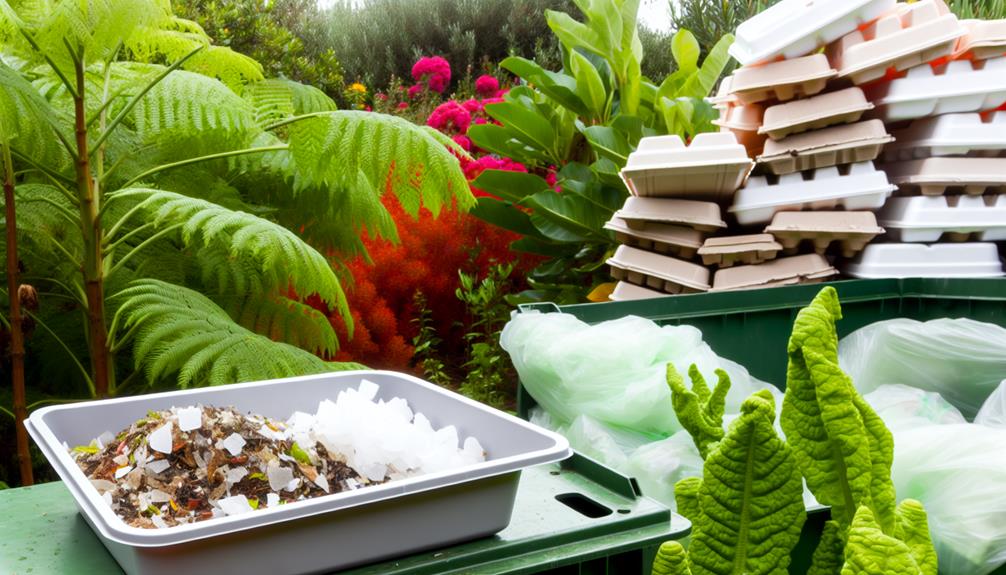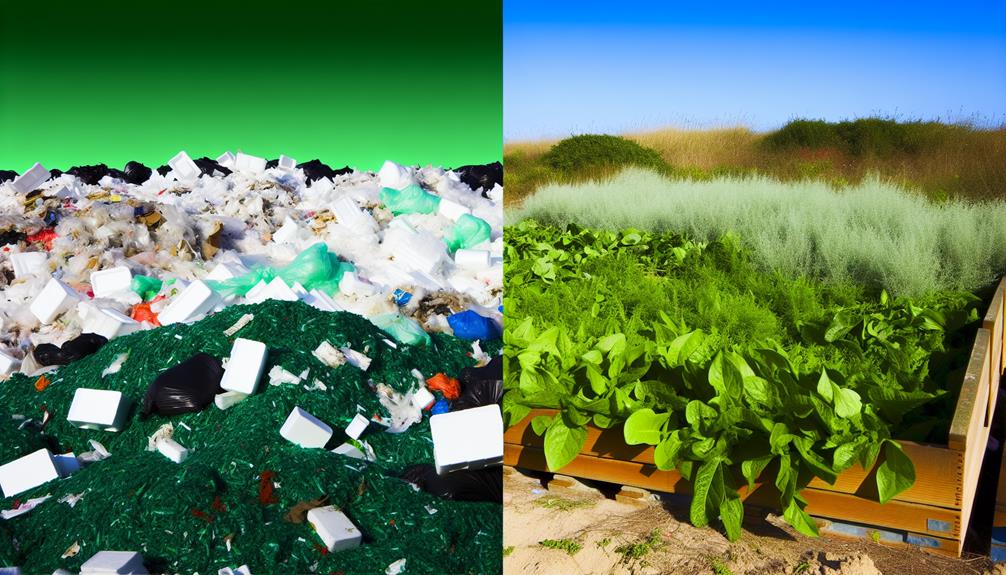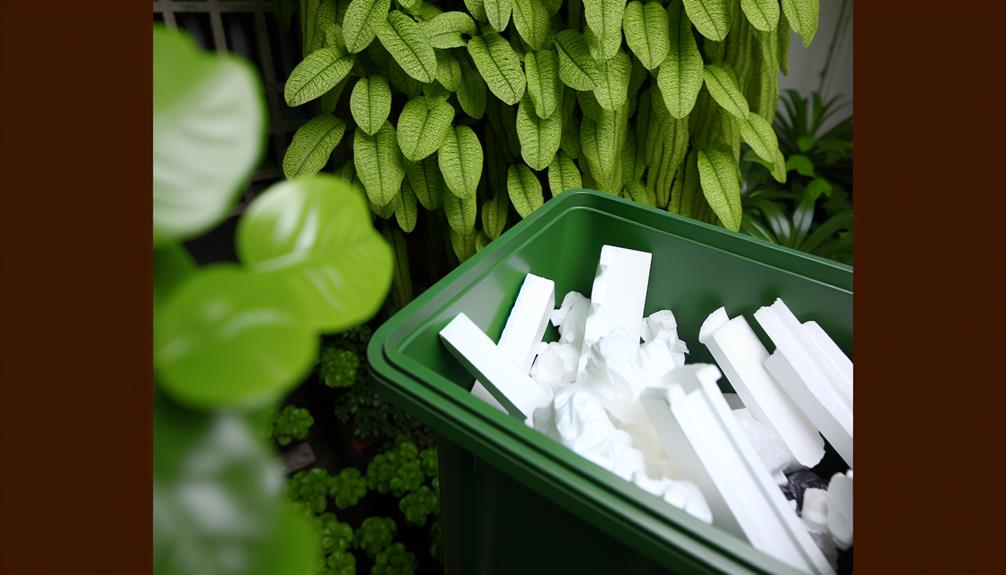

You can’t compost polystyrene because it doesn’t break down naturally and poses environmental risks. Polystyrene, commonly found in disposable cups and packaging, is a synthetic polymer made from petroleum. Its strong, durable nature means it resists decomposition, which leads to persistent waste and pollution.
Instead, you should explore specialized recycling programs or switch to eco-friendly alternatives. Reducing polystyrene use by opting for reusable items and supporting green brands can greatly lessen its environmental impact. Continue exploring to reveal practical steps for proper disposal and sustainable practices.
To understand how to compost polystyrene, it’s important to know the types you’ll encounter: expanded and extruded.
You’ll often see expanded polystyrene in packaging materials, while extruded polystyrene is common in insulation products.
Recognizing these types helps in addressing their recycling challenges and potential composting methods.
Understanding the differences between expanded and extruded polystyrene can help you make informed choices about their use and disposal. Both types share a similar chemical structure, being polymers made from styrene monomers.
However, their polymer properties differ due to their manufacturing processes.
You’ll find polystyrene in a variety of everyday products, each tailored to its unique properties. One of the most common uses is in disposable cups. These lightweight, insulated cups are perfect for keeping your coffee hot or your soda cold, making them a staple in many households and workplaces. Their convenience makes them a popular choice for both individual use and large gatherings.
Another frequent application of polystyrene is in food containers. Whether you’re picking up takeout from your favorite restaurant or storing leftovers at home, these containers provide a reliable way to keep food fresh and protected. They’re designed to be lightweight yet sturdy, preventing leaks and spills while being easy to dispose of after use.
You’ll also encounter polystyrene in packaging materials. Those foam peanuts and molded packaging inserts that protect fragile items during shipping are usually made from polystyrene. Its shock-absorbent qualities make it an ideal choice for safeguarding products in transit.
Understanding the various types of polystyrene products helps you recognize their widespread use and the convenience they offer. By knowing more about these everyday items, you can make informed decisions about their use and disposal.
While polystyrene products offer convenience and versatility, they also present significant recycling challenges due to their diverse forms and properties. You’ll find polystyrene in various types, each with its own recycling complexities.
To tackle these challenges, innovative technologies are emerging, such as advanced sorting machines and chemical recycling methods. These innovations aim to make polystyrene recycling more efficient and effective. However, technology alone isn’t enough.
Consumer education plays an essential role in improving recycling rates. By understanding the different types of polystyrene and knowing how to properly dispose of them, you can contribute to a more sustainable future. Educating yourself and others about proper recycling practices can help reduce the environmental impact of polystyrene waste.
Also Read: Can You Compost Cardboard Tubes?
When considering the environmental impact of polystyrene, you should understand its role in the non-biodegradable waste problem. Polystyrene contributes to pollution and can harm wildlife when not properly managed.

Additionally, its production consumes significant natural resources, raising concerns about sustainability.
Polystyrene’s resistance to decomposition poses a significant threat to our environment. Unlike biodegradable materials, polystyrene doesn’t break down easily, leading to long-term environmental challenges. One of the major issues is landfill overcrowding. When polystyrene products are discarded, they occupy valuable space in landfills, contributing to waste management problems.
Consider the following impacts:
You can make a difference in addressing this issue. Start by reducing your use of polystyrene products. Opt for alternatives such as paper, glass, or compostable materials.
Support local waste management programs that focus on recycling and proper disposal methods. By making small changes in your daily habits, you can help mitigate the non-biodegradable waste problem and contribute to a healthier environment for everyone.
Polystyrene waste plays a major role in pollution and poses serious threats to wildlife. When polystyrene ends up in the environment, it doesn’t break down easily. Instead, it fragments into tiny particles that contribute to marine pollution. These particles, often mistaken for food by marine animals, can lead to ingestion and block their digestive systems.
You’ll find that polystyrene often contains toxic chemicals like styrene and benzene. When these chemicals leach into water bodies, they harm aquatic life and can contaminate the food chain. This not only affects marine animals but also the birds and larger predators that consume them. You can imagine how this disrupts entire ecosystems.
To minimize these impacts, reduce your use of polystyrene products. Opt for alternatives like paper or biodegradable materials.
Participate in local clean-up efforts, helping to remove polystyrene waste from beaches and waterways. By taking these steps, you contribute to reducing marine pollution and protecting wildlife from the harmful effects of toxic chemicals.
Although widely used, the production of polystyrene consumes significant natural resources and energy. When you consider its environmental impact, you’ll realize that polystyrene isn’t as harmless as it seems. To produce this material, manufacturers rely on extensive energy consumption and the extraction of raw materials like petroleum and natural gas.
Here’s a breakdown of the resource concerns:
You should be aware that using polystyrene has larger implications beyond its immediate convenience. The energy and raw materials required for its production make it a less sustainable option compared to alternatives like paper or biodegradable plastics.
Getting a handle on composting basics is essential before diving into the specifics of composting polystyrene. Knowing the composting benefits and methods will set you up for success.
Composting transforms organic waste into nutrient-rich soil, reducing landfill use and promoting sustainable gardening. It can save you money on soil conditioners and fertilizers while fostering a sense of community with fellow composters.
There are several composting methods you can try. The traditional backyard compost pile is a great starting point. It involves collecting green materials like vegetable scraps and brown materials such as leaves. Turn the pile regularly to aerate it.
Alternatively, you might opt for vermicomposting, which uses worms to break down organic waste, producing rich compost in a smaller space. Another method is using a compost tumbler, which makes turning the compost easier and speeds up the decomposition process.
Whichever method you choose, remember to maintain a balance of greens and browns, ensuring proper moisture and aeration.
With these basics in mind, you’ll be well-prepared to understand how different materials, including polystyrene, interact with the composting process.
Understanding how polystyrene breaks down is essential before attempting to include it in your composting efforts. Unlike organic materials, polystyrene, also known as Styrofoam, doesn’t decompose easily. Its polystyrene breakdown occurs over a lengthy decomposition timeline, making it unsuitable for traditional composting.
Here’s a breakdown of what you need to know:
Given these points, including polystyrene in your composting efforts won’t benefit your compost pile. Instead, it will persist in the soil, potentially causing harm.
Understanding the polystyrene breakdown and the extended decomposition timeline helps you make informed decisions about what to compost and what to avoid. This knowledge supports a more sustainable and environmentally friendly approach to managing waste.
Also Read: Can You Compost Cantaloupe?
When polystyrene can’t be composted, switching to eco-friendly alternatives guarantees a more sustainable waste management approach. Consider implementing Bokashi composting and vermiculture to handle organic waste effectively.
Bokashi composting uses beneficial microbes to ferment food scraps, speeding up decomposition and reducing odors. Vermiculture, or worm composting, is another excellent method. It harnesses the power of worms to break down organic material, resulting in nutrient-rich compost.
Here’s a quick comparison to help you decide:
| Method | Key Benefits |
|---|---|
| Bokashi Composting | Fast decomposition, reduces odors |
| Vermiculture | Produces nutrient-rich compost |
| Traditional | Simple, no special equipment needed |
| Community Program | Shared resources, collective effort |
| Green Waste Bin | Convenient, regular pickup service |
Both Bokashi and vermiculture offer unique advantages. Bokashi is great for urban settings due to its compact nature, while vermiculture benefits include producing high-quality compost perfect for gardens. By exploring these alternatives, you’re not only reducing landfill waste but also creating valuable resources for your garden. Engaging in these practices strengthens your connection to sustainable living and fosters a sense of community with others who share your commitment to the environment.
Exploring recycling options for polystyrene can substantially reduce its environmental impact and support sustainable waste management practices.

Here’s how you can make a difference:
Not all recycling centers accept polystyrene, but many specialized facilities do. Find these centers in your community or nearby; they often have the equipment necessary to process and repurpose polystyrene products.
Some alternative plastics are easier to recycle. Materials like polyethylene and polypropylene offer similar benefits while being more widely accepted at general recycling centers. Opt for products made from these alternatives when possible.
Some companies and organizations offer mail-back programs for polystyrene recycling. You can collect your polystyrene waste and send it to these programs, ensuring it gets recycled properly.
Also Read: Can You Compost Carrot Peel?
How can you effectively reduce your use of polystyrene in everyday life? One of the most impactful steps you can take is to switch to eco friendly packaging and sustainable alternatives. This not only benefits the environment but also aligns you with a community committed to sustainability.
Here are some practical tips to help you get started:
| Action | Sustainable Alternative |
|---|---|
| Use reusable shopping bags | Cloth or jute bags |
| Drink from reusable bottles | Stainless steel or glass bottles |
| Pack food in reusable containers | Glass or stainless steel containers |
| Choose biodegradable packing materials | Starch peanuts, paper, or cardboard |
No, you shouldn’t burn polystyrene. It releases harmful chemicals, causing a negative environmental impact. Instead, explore alternative methods like recycling or finding biodegradable options. Let’s protect our planet together by making better choices!
To identify polystyrene in packaging materials, look for Polystyrene labeling or Recycling symbols with the number 6. By recognizing these markers, you can guarantee proper disposal and join others committed to sustainable practices.
You’re right to be concerned about health hazards. Polystyrene can pose toxic exposure risks, especially when it’s heated or burned. Staying informed and making safer choices can help protect your health and the environment.
You can get creative with recycled polystyrene by using it in art installations or as building insulation. By doing this, you’re contributing to sustainability and joining a community dedicated to innovative, eco-friendly solutions.
Yes, polystyrene contamination can harm soil quality. It disrupts soil biodiversity and negatively impacts microbial health. By being mindful of your waste, you help protect our shared environment and promote a healthier ecosystem for everyone.
You can’t compost polystyrene, as it doesn’t break down naturally. Instead, focus on recycling it through appropriate programs and reducing your use of it.
Opt for materials that are compostable or recyclable. By making informed choices, you’ll help minimize environmental impact.
Always check local guidelines for disposal and consider alternatives like reusable containers. Your efforts in reducing polystyrene use make a substantial contribution to a healthier planet.
